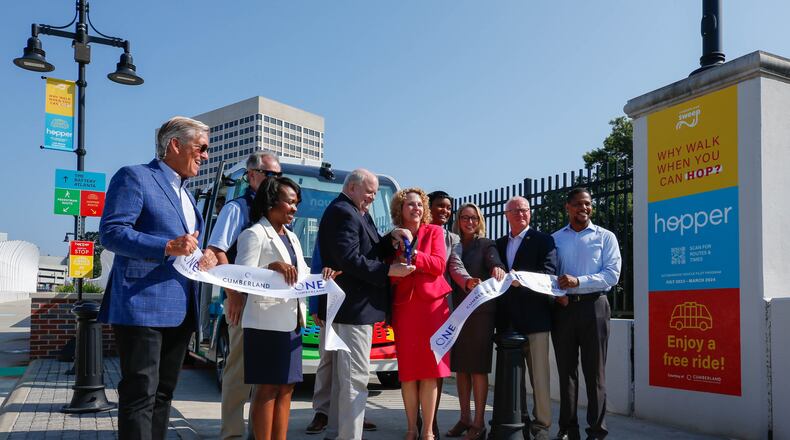The Cumberland Sweep, dubbed Cobb County’s version of the Atlanta Beltline, is a multi-use path project slated to bring over three miles of bike lanes, pedestrian paths and a self-driving shuttle system to the busy business district.
The project is estimated to cost well over $100 million, excluding the cost of seven or eight shuttles. It will eventually form a circle around Truist Park, the Battery, the Cobb Galleria, the Cobb Energy Performing Arts center, Cumberland Mall and other major hubs in the Cumberland district — one of the most exclusive and expensive areas in Cobb County.
Yet Cumberland officials, in partnership with the Cobb County Commission, have for three years now sought federal grants for the project that are geared toward helping underserved or disadvantaged communities.
Each application for those grants has thus far been rejected.
Kim Menefee, the CID’s executive director, acknowledged that the Cumberland area is not underserved. But, she said, the Sweep project will connect to the county bus system, which in turn will help people from those areas access jobs in Cumberland.
Credit: Katelyn Myrick
Credit: Katelyn Myrick
“We do have underserved communities that do surround the Cumberland district that will benefit from the Cumberland Sweep project,” Menefee said. “Our goal is to be able to offer this connectivity for those who don’t own a car, or who choose not to drive a car. We have a broad array of jobs, and we want to make sure that people have access to those.”
But Nathanial Horadam, a transportation planning expert, said that argument doesn’t make much sense.
“Most of the people working in that area, because they lack effective transit solutions even to get to the area, are going to drive anyway,” he said. “...And the housing they’re putting in there is going to be (for) higher-income (people).”
District officials applied unsuccessfully for two grants typically reserved for low-income areas: the federal Reconnecting Communities grant and the Rebuilding American Infrastructure with Sustainability and Equity (RAISE) program.
When awarding funds for these programs, the U.S. Department of Transportation considers “impacts to historically underserved or overburdened communities” that face persistent poverty — which Cumberland does not.
The city of Atlanta this year won a grant through the Reconnecting Communities program to plan a park over I-75 and I-85 called the Stitch, designed to reconnect the historic Black communities that were torn apart by the downtown connector. Similarly, officials in Buffalo, N.Y. are utilizing the Reconnecting Communities grant to create a cap park restoring connectivity above a highway that “resulted in the Black residents of Buffalo being isolated in areas with low access to jobs and institutions such as grocery stores and banks.”
Cumberland’s Reconnecting Communities grant application says the Cumberland Sweep will “provide vital transportation options for underserved communities,” including for people who are employed by the businesses in the Cumberland district.
“Providing access to these jobs is pivotal to addressing the transportation equity issues in the Cumberland area which are severed by major roadways,” the application says.
The city of New Orleans won $25 million through the RAISE grant to build a downtown transit center for its bus and streetcar network, and Illinois won $20 million to create a bus rapid transit service for four south-side Chicago neighborhoods to expand public transit connections into the southern suburbs.
Cumberland CID officials wrote in its RAISE application: “Although CCID lacks disadvantaged communities within its boundaries, employers in the area retain individuals from underserved, disadvantaged communities from the Atlanta metropolis. ... Furthermore, with 60% of the CCID population being minorities, this Project will help create equity for households that face unfair levels of inequity.”
The Cumberland district includes about six square miles in east Cobb County bordering the city of Atlanta. It is a special tax district of commercial property owners that pay an additional property tax to support infrastructure and beautification improvements in the area.
The Sweep project has received $10.7 million from other federal funding, including $6.4 million through an Atlanta Regional Commission grant. The CID has committed $2.6 million of its own money, some of which is a required match to receive grant funds.
“What we’re trying to do is plan for growth, and how the district was changing because we have — not only are we a major job center, now we have a huge residential component to the CID,” Menefee said.
The Cumberland Hopper
In July, improvement district officials unveiled the Cumberland Hopper, an eight-seat autonomous vehicle piloted for the project that cost about $400,000. The pilot shuttle was funded completely with CID money.
Officials aim to implement seven to eight self-driving shuttles into the Cumberland Sweep.
Credit: Katelyn Myrick
Credit: Katelyn Myrick
Cobb County transportation director Drew Raessler called the project “innovative” and said the county is supportive of expanding transit options.
“When we look at Cumberland as a district, there are so many great attractors there,” Raessler said. “And those are very long walking trips — too long to walk, too short to drive — and the Sweep provides the opportunity to make those last-mile connections.”
But Horadam, who studied AV technology and transportation planning at Georgia Tech and used to work for the Center of Transportation and the Environment leading its automation program development, called automated shuttles “old technology” and likened them to “toasters on wheels.”
He said the industry has moved away from these types of shuttles, and that is likely another reason the district’s grant applications have been unsuccessful.
“It’s been proven not to work, and most cities have kind of moved on from those ideas,” Horadam said. “And yet, the Atlanta suburbs still seem to be enamored, I think, for lack of understanding how ineffective they are.”
While self-driving vehicles can operate on their own, they still need an attendant on board to take over if anything goes awry. That calls into question whether they are truly “autonomous,” Horadam said.
A 2021 report published by the National Academies of Sciences, Engineering, and Medicine found that low-speed autonomous vehicles face several challenges, including their slow operating speeds, difficulties in making unprotected left turns and “oversensitivity to objects triggering abrupt stops.”
Credit: Katelyn Myrick
Credit: Katelyn Myrick
“So U.S. DOT won’t even give them planning money,” Horadam said. “I think that speaks volumes about the project’s merits as a whole.”
Menefee said discretionary grants like these are highly competitive and sometimes take several years of applying before actually getting them.
Federal transportation officials recently awarded $20 million in RAISE grants to the Gwinnett County transit center, and $25 million to the Atlanta Beltline trail expansion to connect affordable housing with public transit and job centers.
Those types of projects, Horadam said, are what federal transportation officials are prioritizing.
“They’re amusement park rides,” he said of AV shuttles.
Menefee disagrees and said U.S. DOT is continuing to fund autonomous mobility projects similar to the Sweep.
“What we’re seeing is the technology is continuing to advance,” she said. “Autonomous mobility solutions are very much the future, and we believe that this project, and this pilot in particular, will help us with our planning effort for mobility solutions for the future.”
About the Author
Keep Reading
The Latest
Featured






